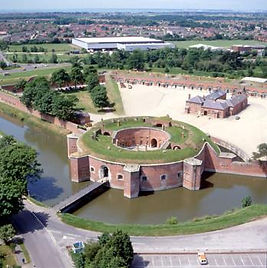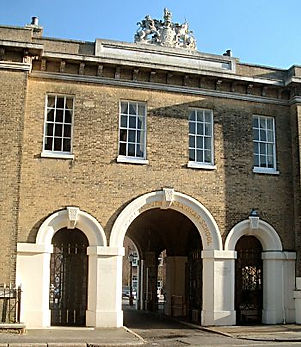Willie/William John Richards Early life


Portsmouth 1854 - ca. 1870
The map above is dated 1855, the year after our Willie John was born. As you can see there are large empty areas of, presumably fields, where today the entire island (and beyond) is town. The town of Portsmouth itself was then just a small part of Portsea Island itself with the smaller townships of Fratton, Kingston, Portsea and Hilsea in existence, although Southsea, where some of this story is set did not really exist. Clicking on the map will take you to a larger version where you can just see the old fortifications around old Portsmouth and Portsea. These were pulled down in the 1860s, as they were no longer relevant, and a series of new forts were built across Portsdown Hill which overlooks the town. Brockhurst Fort, which is one of them, is shown above.
Portsmouth, of course, is and almost always has been a navy town, and for most of its history has been somewhat dependent on war for its prosperity. Not a problem you would think, but apparently there have indeed been periods of depression when there was not much need for warships. But I imagine this can’t have been when William was born. The Victorian empire was at its peak with colonies all over the world that needed keeping in order. The Crimean War was in full flow when Willie was born - it finished in 1856 and the Indian Mutiny took place in 1857/58. Although all of these wars and skirmishes mostly involved the army, no doubt they were backed up by the navy, and the soldiers certainly needed to be transported there. The dockyard itself was hugely extended in 1864 - so massive were the extensions that they were able to use the mud dredged for the basins, to create a whole new island. However, Prince Albert died in 1861 and Victoria went into mourning, and, it has to be said, into semi-neglect of her duties as sovereign.
Unusually for the times, the next known child is not born for another seven years, followed by another gap of four years. The remaining children were girls - Ellen born in 1863 and Jessie born in 1867. It is impossible to tell whether there were miscarriages or infant deaths in between. The census records make no mention of other children, and with a surname like Richards it is impossible to tell from the birth indexes whether there were other children. The IGI parish register records imply there were no others, though some of the parish register records for the period are not included in the IGI. Curious. So as it stands Willie John was the oldest child and only son in a very small family of three children at a time when the average family size would have been at least six or seven children. Willie, himself, fathered nine children. Why this should be is really his father’s story not this William’s.
He was born on 10th August 1854 at 5 Bedford Street, Southsea. Bedford Street is still there, but the Google Earth satellite seems to imply that there are no longer any houses in it. But then large chunks of Portsmouth were flattened in the war, and rebuilt into different configurations. Bedford St. is about in the middle of the word ‘Portsmouth’ on the map above. The street scene on the right is of a modern street in the area and the houses look fairly old, so it was probably much like this. The photo on the left is of an old mill in Southsea and probably gives a better idea of what the area was like.
His father would have been working in the dockyard - which is the dark looking area on the bottom left of the map, just below the islands, so they would have been part of the working class of dockyard workers who kept Portsmouth going
There are pluses and minuses in this situation of course - mostly pluses one would have thought, in that there would have been more spare money and more space. I have no doubt that the lack of childhood siblings and therefore playmates would have been made up by friends made in the neighbourhood or at school. The picture below is of a group of children playing in the street - a tradition which continued in most English towns for most of the next century. At the age of six he was still living in the same street, though at number 9, so probably had made lots of friends there.
Another advantage of coming from a small family may have been spare time and money to spend on education. Willie (or William as it seems we must now call him) must have had a good education because he obtained an apprenticeship at the Dockyard (more on the next page). From the 1868 National Gazeteer we discover that Portsmouth was well-provided with schools :
“There is a free grammar school at Portsmouth, founded by Dr. Smith in 1732, the Benefit Society's at Portsea, a seamen's orphan school, nine National schools, one Roman Catholic, one at the workhouse, and more than 300 other schools of various descriptions, in addition to numerous Sunday-schools.”
I have no idea which one William attended - maybe he went to the grammar school, (shown below right) which at that time was for boys only. In the 1860s girls probably didn’t get much chance at an education beyond basic literacy.

Willie John Richards seems to have been the firstborn son, first child even, of William John Richards and his wife Emma Turner. His birth certificate gives his name as Willie John, but every record we have (and we have most of the official ones) gives his name as William. Maybe even back then, Willie was not a good name for a boy and was discarded rapidly! Curious isn’t it? Usually this sort of thing happens the other way round with the given name devolving into a pet name.






Links
History in Portsmouth - a site compiled by amateur local historians with pages on topics of interest to them. So doesn’t cover everything, but what it does is interesting.
Hantsphere - a similar kind of site

Links
William John Richards
